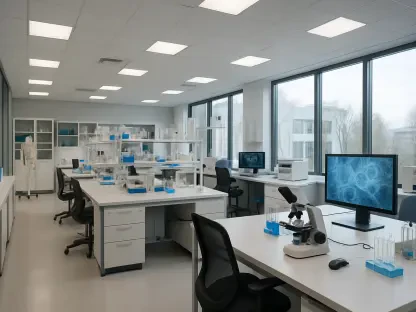In the evolving world of nuclear medicine technology, technetium-99m has emerged as a pivotal component in diagnostic imaging, underpinning advancements in medical diagnostics. With the increasing prevalence of chronic diseases, coupled with technological prowess, technetium-99m is poised to significantly transform healthcare landscapes across the globe. As demand for early-stage disease detection strategies intensifies, the role of this isotope in non-invasive diagnostic procedures becomes paramount. The global market for technetium-99m exhibits robust growth potential, offering insights into how this technology could shape the future of diagnostic imaging.
Market Growth and Dynamics
Driving Factors and Opportunities
The technetium-99m market is gaining momentum, fueled by an array of factors that contribute to its burgeoning demand. A notable factor is the escalating prevalence of chronic conditions such as cancer and cardiovascular diseases, which necessitate more sophisticated imaging solutions for timely diagnosis and treatment planning. The isotope’s properties, including optimal gamma-ray emission and a short half-life, make it an ideal choice for diagnostic applications, minimizing radiation exposure for patients. Government initiatives aimed at enhancing healthcare accessibility and the growing geriatric population further propel market expansion.
Technetium-99m has a far-reaching impact on improving diagnostic accuracy and facilitating early disease detection. Its application in imaging offers improved insights into complex health issues, ensuring precise identification and treatment strategies. Key to its market growth is the steady advancement in diagnostic imaging technologies, including hybrid imaging systems and the adoption of Single Photon Emission Computed Tomography (SPECT), which leverage the benefits offered by technetium-99m. These innovations enable detailed visualization, thus supporting accurate assessment and efficient clinical decision-making.
Regional Insights and Market Forecast
In the global market, North America stands out as a dominant player due to its well-established healthcare infrastructure and a high concentration of nuclear medicine departments. This region’s leadership is bolstered by substantial investments and continuous advancements in medical technologies. However, the Asia-Pacific region is experiencing a rapid ascent as it develops healthcare infrastructure and increases investments in diagnostic technologies. The region’s focus on early disease detection aligns well with the capabilities offered by technetium-99m, positioning it as a growth powerhouse.
Asia-Pacific’s expansion is propelled by factors like improving healthcare accessibility, government-backed healthcare initiatives, and a growing population seeking quality medical services. With substantial investments being directed towards enhancing healthcare delivery, this region is set to contribute significantly to the overall market growth rate. Projections indicate that the technetium-99m market, valued at USD 7.15 billion in 2024, is on track to reach USD 11.46 billion by 2034, growing at a compound annual growth rate (CAGR) of 4.83%.
Technological Integration and Challenges
Role of Technological Advancements
Artificial Intelligence is playing an increasingly vital role in revolutionizing the production and application processes of technetium-99m. It optimizes supply chains, augments production efficiency, and enhances clinical outcomes. These advancements facilitate the seamless integration of technetium-99m in diagnostic imaging, thereby improving healthcare delivery and minimizing costs. AI-driven systems allow for precise control over logistics and production schedules, effectively addressing the challenges posed by the isotope’s short half-life.
Furthermore, technological breakthroughs contribute to the reduction of logistical difficulties associated with technetium-99m production and distribution. Innovations in imaging technologies, such as spectral CT and advancements in automation, are slated to further streamline operations, making the isotope’s deployment more efficient. This increased efficiency supports healthcare providers in overcoming existing logistical barriers and elevating diagnostic care.
Logistical and Financial Constraints
Despite the promising growth prospects of technetium-99m, substantial challenges remain concerning logistics and finances. The isotope’s short half-life demands meticulous coordination in production, transportation, and clinical application, often leading to logistical complexities. These challenges require healthcare facilities to invest significantly in infrastructure to ensure timely and adequate supply of the isotope for diagnostic purposes.
Additionally, the high cost of producing technetium-99m, exacerbated by regulatory compliance, safety measures, and infrastructure investments, creates barriers within emerging markets. Navigating these financial hurdles requires strategic planning and innovative solutions to mitigate costs while maintaining compliance with stringent regulatory standards. Enhanced collaboration between stakeholders can pave the way for cost-effective ways to harness the benefits of technetium-99m.
Navigating Market Barriers and Advancements
Regulatory Challenges and Potential Solutions
Regulatory compliance presents a formidable barrier in the wider adoption of technetium-99m in emerging markets. Stringent safety protocols necessitate significant investments in both infrastructure and personnel training, occasionally stalling widespread application. Industry stakeholders are increasingly focusing on streamlining processes and optimizing resource utilization to effectively navigate these regulatory constraints.
Exploring innovative approaches to production and distribution, such as leveraging regional partnerships and cooperative ventures, can bring about cost reductions and increased efficiency. By sharing resources and expertise, healthcare systems can enhance operations while maintaining compliance with international standards. Additionally, adopting technology-driven methods for regulatory management can expedite approval processes, ensuring timely dissemination of these valuable diagnostic tools.
Leveraging Advanced Imaging Systems
The adoption of advanced diagnostic imaging systems, including hybrid imaging techniques, bolsters the application of technetium-99m by enhancing imaging detail and resolution. These systems, particularly SPECT, provide improved diagnostic accuracy and contribute significantly to the market’s upward trajectory. As healthcare providers increasingly embrace advanced technologies, the reliance on more refined imaging techniques reinforces technetium-99m’s relevance in medical diagnostics.
Healthcare systems are progressively integrating hybrid modalities that combine the benefits of different imaging technologies, thus expanding diagnostic capabilities. These innovations align with the growing demand for comprehensive diagnostics that are both effective and precise. Such advancements are crucial in maximizing the potential of technetium-99m, further propelling its market growth in diverse regions globally.
Insights into Future Market Dynamics
The Strategic Importance of Technetium-99m
Looking forward, technetium-99m remains a central component in shaping the future of diagnostic imaging, with immense potential for market expansion. As healthcare systems globally pursue strategies that prioritize early disease detection, the isotope’s beneficial properties become indispensable. Stakeholders must adapt to evolving infrastructural and regulatory landscapes to harness technetium-99m’s full potential in medical diagnostics.
The continuing development of healthcare infrastructure, coupled with technological integration, bolsters the market’s growth trajectory, providing ample opportunities for expansion. By leveraging advanced technologies and navigating logistical hurdles, providers can ensure seamless deployment of technetium-99m, thereby tapping into future growth prospects.
Future Outlook and Strategic Directions
In the rapidly advancing field of nuclear medicine, technetium-99m stands out as a key element in the realm of diagnostic imaging, driving forward progress in medical diagnostics. The rise in chronic illness incidence, combined with cutting-edge technology, positions technetium-99m to make a significant impact on healthcare systems worldwide. As the need for early-stage disease detection becomes more pressing, this isotope plays a crucial role in non-invasive diagnostic methods, offering a blend of precision and efficiency. This importance is accentuated as healthcare focuses on catching diseases at their inception, where intervention is most effective. The worldwide market for technetium-99m reflects strong growth potential, suggesting how this technology is set to influence the future landscape of diagnostic imaging. Its abilities to help visualize internal structures without surgery make it indispensable in modern medical practice. As we look ahead, technetium-99m will likely continue to be integral to developing more sophisticated, accessible, and efficient diagnostic techniques, cementing its place as a cornerstone in medical innovation. This underscores the transformative potential of technetium-99m, as it is not merely an agent of change but a harbinger of the future in healthcare diagnostics.









